Beautiful curly liaans will always be popular among gardeners to decorate household plots. An indelible impression always leaves wisteria - a tree liana with gorgeous hanging blooming brushes. This plant, occupying quite a bit of time, has simply exceptional decorativeness.
Everyone who has ever seen wisteria during flowering, will never forget this beauty and will seek to grow a similar miracle in his garden. Growing conditions for wisteria in open ground rather strict, because it is an exotic thermal-loving culture, so it is necessary to closely recreate the usual and comfortable environment for it. Beautiful purple-blue and white brushes of wisteria will give any structure or sector eastern atmosphere and fill your garden with a wonderful aroma.
In this article, consider the features and description of wisteria, we present the characteristics of popular varieties for open soil. And also note the most important points of how to grow wisterium on its site.
Features and Description of Wisteria
Wisteria is a tree-like leyana, which refers to the family of climbing and is a representative of the bean family. This is a plant subtropical, since the natural habitat of this beautiful Liana is the southern territory with a soft and warm climate. Often tunnels from Wisteria, accused the facades of the house, Arches can be found in the Crimea, on the mineral waters, in the Kuban, in the North Caucasus. Among the nerd scientists for a long time disputes were conducted as to what wisteria is a flower or liana. However, after all, everyone came to the conclusion that this is a curly blossoming liana whose beauty just fascinates. After all, no wonder the most beautiful and bright flowering plants come from the tropics and subtropics. It is there that all plants are pleased with lush and abundant blossom, which is peculiar and wisteria.
Translated from the Greek word "wisteria" means "sweet". It is possible to explain it just an incredible sweet aroma that exudes the blooming wisterium throughout the summer. This plant has another name - this is Visteria, which wisteria received in honor of the scientist, professor anatomy of the University of Pennsylvania Caspar Vistara.
In total, 9 types of wisteria are known, but only three of them can be seen in the open soil of our climatic belt. Growing of wisteria is also possible at home as a bonsai tree.
Description of Glicia
- Glicinia is a leaf falling liana, which grows in the form of a tree.
- The crown of the plant is formed by long drooping branches.
- In height, adult wisteria can reach 18-20 m, the crown will also grow with time and can be in diameter of 8 m, creating a beautiful blooming tent.
- Wisteria can grow as a common tree with a rather thick barrel, and may have a form of a fucked liana that can decorate quite large areas.
- Plant branches are covered with large complex leaves. In structure, they are unparalleled, on average consist of 7-8 small leaves. In total, the length of one sheet can be 30 cm.
- In young age, the leaves of wisteria have a slight omission, which over time disappears. The color of foliage light green.
- Flowers of wisteria can be of a wide variety of shades: white, blue, purple, light pink, purple.
- Collected flowers of this plant into long-shaped inflorescences, which can reach a length of 30-50 cm, and in some varieties, the brushes are pulled by 70 cm.
- Flowering wisteria begins in March or April and lasts almost until the end of the summer. All this time, the garden is filled with a charming fragrant aroma, which very much resembles the smell of acacia.
- After grazing at the brushes, beans appear, which are seeds of wisteria suitable for breeding.
- Different types of wisteria are distinguished by varying degrees of frost resistance. Chinese wisteria can withstand frosts up to -20, and abundantly-flowing is the most stable view - can grow at -40.
- Although this culture is considered subtropical Lian, however, you can grow wisterium in the middle lane. It will not have such large sizes as the southern neighbor, and flowering will be more scanty, but you can admire this eastern beauty at any time.
Variety of species and varieties of wisteria for open soil
In total, there are 9 types of wisteria in nature, but only a few of them can be grown in the open soil. First of all, this choice is due to the frost-resistance of the plant and its duration of flowering, as in the middle lane of our country there are quite strong frosts that are able to withstand not all exotic wisteria. Consider the characteristics of the most popular types of wisteria in our gardens.
Chinese wisteria
- This is the most popular and common view of the blooming liana, which can be grown in the open ground. In more northern areas, planting Chinese wisteria is carried out in containers.
- This species is characterized by a large number of variety of varieties that have different shades of inflorescences.
- If you correctly care for Chinese glycine, this liana can be in height to reach 20 meters.
- Purple, lilac or light-pink flowers are collected in creeps-shaped inflorescences, which in length reach 30-40 cm.
- Flowers have a pleasant fragrance.
- Flowering Chinese wisteria begins at the beginning of spring and lasts almost until the end of summer. The way wisteria is Chinese during flowering, it is difficult to convey words.
- After the flows of classes of wisteria, beans appear on the brushes, the length of which is about 10-12 cm. Inside these beans are plants seeds.
- Selectioners recently replaced several garden forms with terry inflorescences and white, which look perfectly in landscape design.
- It can be grown in tree shape, strabovoy, rectifiable and fusing form.
Glicinia Abundant or Floribund
- Also a very popular species of wisteria, whose varieties often offer to customers in the colder regions of Russia.
- In height, this liana reaches 8-10 meters.
- The leaves of the wisterium of the abundant or fine-cexual very large size, can be approximately 40 cm. In structure, complex, consist of 19 small leaves.
- Unlike Chinese wisteria, this species has smaller flowers that are collected in private inflorescences. Brushes are very dense and consist of a lot of colors.
- Cystic inflorescences in length can reach 50 cm and have a bright purple-blue tint.
- Glicinia blooms of this species a little later than the previous variety, while the flowers in the brushes are dissolved gradually, ranging from the base.
- The gardens are grown as a decorative plant from the 19th century.
- It is distinguished by wisteria. Radyless frost resistance, can withstand frosts up to -23 degrees.
- The wisteria of this species has several interesting garden forms: liana with white flowers, wisteria with long brushes up to 1.5 m, a variety of liana with terry flowers, a variety with pale pink-shaped inflorescences, variety of lianas with motley leaves.
Glicinia Shustaikovaya
- This liana in height can reach 12 meters.
- The crown is formed by drooped branches with a large number of leaves of 7-8 cm long.
- Flowers plant with beautiful purple blue inflorescences.
- In nature, it grows in the warm regions of the Crimea and the Caucasus, in the cooler regions, this Liana can be grown in ads and containers.
Glicinia reproduction: the most common ways
Glicinia can be diluted independently at home. For this, there are several ways: seed reproduction, reproduction with tanks and cuttings. Each of the above methods is characterized by features and techniques of execution, which must be considered when choosing optimal for you. Consider in more detail the characteristic of each method of reproduction of wisteria.
Seed reproduction of Glicia
- The seed method of reproduction is quite cunning, as in the end you can get an adult plant without varietal signs or generally Liana, which will never bloom. Explain such a phenomenon still cannot scientists. Most often, seminal reproduction use breeders to remove new grades of wisteria.
- Seeds of wisteria can be assembled independently, but for this it is necessary to wait for the full ripening of fruits. After that collect them and dry them. Alternatively, seeds for sowing can be purchased in the store of goods for the garden and garden.
- Seed seeds are recommended at the end of autumn or at the beginning of winter in containers.
- To do this, first of all, it is necessary to prepare the soil mixture, which should consist of a sheet of land, delicate earth and sand.
- In front of the seeds, seeds can be soaked for several hours in the growth stimulator solution, then drink them on the surface of the substrate and plucked the sand slightly.
- Seeds must be moistened and cover with a film container to create a greenhouse effect.
- So that your seeds are sprouted, the container with them must be stored in a dark room and with a temperature of not lower than 20 degrees. It is important to regularly care for sowing: to air and moisturize from the spray.
- Usually in a month the first searches appear. Only after this container must be placed on the windowsill. In this case, it is necessary to protect the crops from direct sunlight.
- When 2-3 leaves appear on seedlings, they can be divened to individual pots. Only to do it in such a way that the soil from the container remains on the roots. After landing, you can treat the soil with a weak solution of manganese.
- From this point on, it is necessary to take out a couple of hours outside, so that young seedlings of Wisteria are gradually choke and have become accustomed to weather conditions.
- If you decide to grow wisteria with seeds, remember that the percentage of their germination is very low. Usually approximately 25% of the total.
Glicinia reproduction
- This method of reproduction is more popular and gives better and positive results than seed.
- It is necessary to carry out the reproduction of the tanks in spring until the moment of active vegetation and the appearance of foliage.
- To do this, on an adult plant, choose a healthy and high-quality escape, which is closest to the surface of the Earth.
- Take a sharp knife and on the middle of the length, make an oblique incision on the brass. After that, many gardeners recommend processing with Indolyluxus acid tensions. This will increase the percentage of rooting almost twice.
- Prepare containers with soil mixture, which should consist of a delicate land and clay soil.
- The jackets are stacked with cuts down containers and poured soil in such a way that only the tops remain on the surface.
- For reliability, the tank can be fixed using special brackets or ordinary wire.
- During the spring and summer, behind the tanks are careful as an adult plant. By the end of the summer, they will have strong roots, but it is possible to disembark from the mother's bush only the next spring.
Glicinia reproduction with cuttings
- This method is not as popular as the previous one, however, it can also be used for glycine breeding on its own.
- Glicinia cuttings are cut from a long vine. Cut it at the end of autumn.
- The length of one cutter should be approximately 15-20 cm.
- Before rooting the cuttings, they can be placed in the solution of growth stimulator so that the rooting passed more efficiently.
- For rooting, a special soil mixture is used, into which all the cuttings are placed and put a container with them into the cellar for the entire winter.
- In the spring, the cuttings are riveted and rooted in the open soil and top cover them with plastic bottles or banks.
- The hauling is rather not a reliable way of reproduction, since the percentage of the survival of such cuttings is very low - even 50% does not come true.
Preparatory stages before planting wisteria in open ground
Glicinia is a subtropical leaf pader, which prefers to grow in a warm and soft climate. Therefore, to plant this exotic plant in the climatic conditions of our country, it is important to carefully and correctly conduct the preparatory work, which should be included in the acquisition of landing material and choosing on its site of an optimal landing site.
Stage 1. Selection of grade and planting material of Wisteria
- If you are going to plant wisteria in the southern regions of Russia, you can use absolutely any variety of this beautiful liana.
- For colder regions, it is best to choose the varieties of Chinese and abundant lianas. The variety of American Blue Moon selection is particularly popular, which is characterized by high frost resistance.
- You need to acquire seedlings only in specialized nurseries or agrofirms, which are professionally engaged in breeding various plants.
- You only need to buy seedlings for 2 years, which have already become stronger than the strong roots.
- Before buying, be sure to carefully check all seedlings. They should not be visible damage and signs of disease. A healthy and strong young plant should not have dried and faded shoots and leaves. The soil in the container must be clean and well-groomed.
- In no case do not buy seedlings of such a rare plant, like wisteria, in natural markets and roads. So you exactly risk getting a completely different plant.
Stage 2. Selection of places for landing of wisteria
- From the correctly selected place will depend on the further growth and development of your wisteria.
- Wisteria is a heat-loving plant, so the most important condition for its cultivation will be the choice of sun and outdoor.
- It is important for her growth that the first half a day the sun shine on it.
- The selected place should also be protected from strong winds and drafts that can damage the plant.
- It is best to put wisteria on a small hill.
- When choosing a place for landing wisteria, be sure to take into account the fact that it is a perennial plant and it does not make transplants.
- Wisteria can be landed near the house and let her branches on the wall so that in the future to get a beautiful composition.
- Wisteria can land near the gazebo or terraces that in a few years will be completely covered with decorative leaves and bright colors.
- If you decide to plant wisterium into the container and take it into the loggia or terrace for winter, find a suitable place for it in the area.
Stage 3. Choice and preparation of soil for wisteria
- Wisteria prefers to grow on light and loose soils that have a weakly alkaline reaction. If the soil is sour, then, be sure to add the lime of wood ash in them when processing.
- It is important that the soil is nutritious. To do this, you can add any organic organics, for example, humus.
- Wisteria will grow well only on drained soils, so you need to take care in advance.
- For a while before the landing of wisteria in open ground soil in the selected place, it is important to carefully switch, add the organic and lime. Mix everything well, explode and dissolve.
Glicinia planting technology in open ground
- Planting wisteria to open ground is carried out in spring. It is important to wait for time when the threat of the last frost passes, because young plants are not so cold-resistant as adults, so they can die.
- At your chosen area of \u200b\u200bthe Earth, it is necessary to prepare landing points, the size of which should be about 60 cm deep and 60 cm in width. Always focus on the root system size along with an earthen room - the pit must be twice as much.
- At the bottom of the pit, pour the drainage layer, which later prevents stagnation of water in the roots. As a drainage, small stones, gravel or broken brick can be used. If you plan the seedling into the container, it is also necessary to place a drainage layer on the bottom.
- The container with a seedling is necessarily water to facilitate the extraction of the plant.
- Place young plants in the wells and pour the soil mixture into which therefore add a bit of complex mineral fertilizer.
- The soil around the seedling gently complies with his hands.
- Do not wait for rapid growth from wisteria. Most often, a full-fledged plant with flowers grows only after 5-10 years.
Glicinia Growing Agrotechnology: Secrets and Nuances of Care
Caring for glyciny is not much different from other blooming plants, the only thing, the trim will have much more often.
- Watering. Fall pader Liana wisterium requires regular and abundant irrigation, especially for summer and springtime. You need to water often, but at the same time keep track of not to pour your plant. You can navigate on the state of the soil - before watering it should be slightly wet. It is best to use the spraying method. From mid-September, watering should be gradually cutting.
- Loosening and mulching. Several times for the season it is recommended to loosen the soil around the plant, in parallel, removing weeds. The priority circle is recommended to be mulched to prevent the evaporation of moisture and overheating roots. The mulch is used peat or sawdust.
- Feeding For beautiful and magnificent flowering, it is important to regularly feed the wisterium during the actively active vegetation. This uses complex mineral fertilizers and organic, such as the infusion of a cowboat. Fertilizers need to alternate and contribute once a week.
- Crossing wisteria. The tree liana wisterium requires constant trimming, so that its crowns will always be decorative. From wisteria, you can form a strambette plant, in which case the central escape is selected, and the rest are cut. If you want to get plenty wisteria, then you need to delete all the side shoots. Pruning is that it is necessary to crop sticking young shoots, and the side young shoots should be shortened by 30 cm so that inflorescences appear on them. During the flowering of Wisteria, it is important to delete all the sworded buds, it will stimulate the growth of new ones.
- Winter wintering. If you grow wisteria in the cool regions of Russia, it is important to carefully cover it before the winter onset, otherwise your beautiful liana can perish. To begin with, it is highly occurring the rolling circle and pour the mulch layer. Next, carefully remove the shoots from the supports and turn them around the trunk. Blank branches with foliage and underfloor material.
Use of Wisteria in Landscape Design
- Glicinia is very popular among gardeners and landscape designers around the world for its exceptional decorativeness. At the same time decorative not only flowers, but also leaves.
- Wisteria can be grown as a strambered plant and pick up a place for it against the background of lawn and surrounded by lower plants.
- Alternatively, wisteria is planted for the soaring arbor, terraces, arches.
- If you live in the middle lane of Russia, wisteria seedlings can be planted in pots and containers and arbitrarily arbitrarily placed on the site.
Photo of Glicia
Glicinia is one of the most beautiful and ornamental lian, which is an excellent decoration of any plot. It is not necessary to scare the difficulties associated with planting and leaving for this culture, the main thing is to choose the right grade and pay an eastern beauty to the maximum attention.

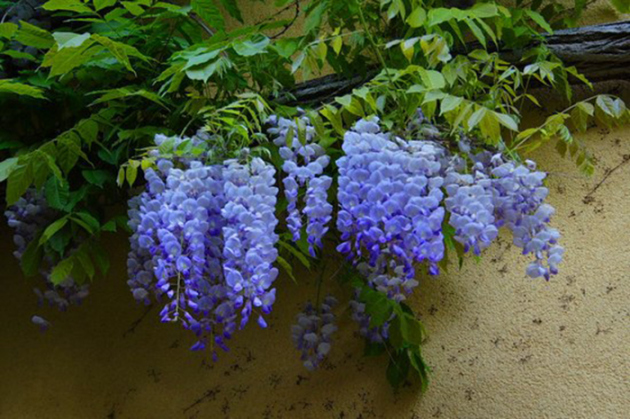
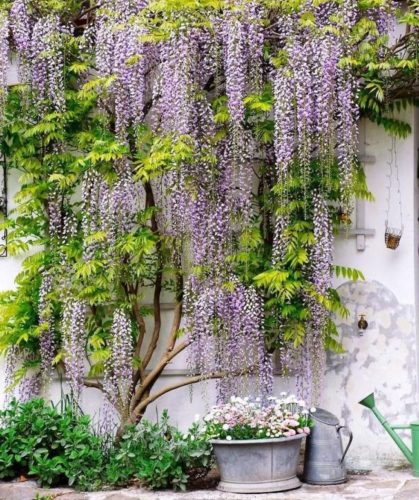
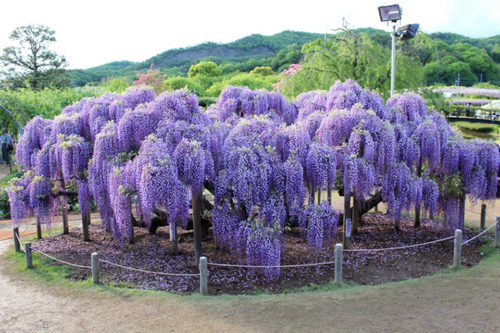

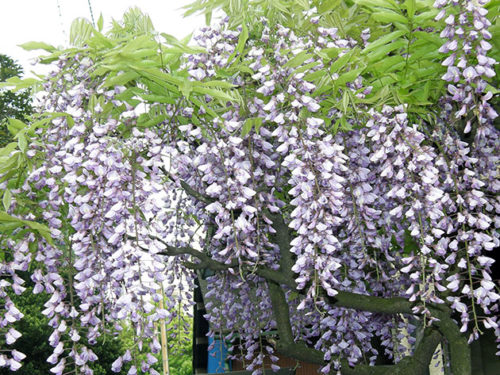
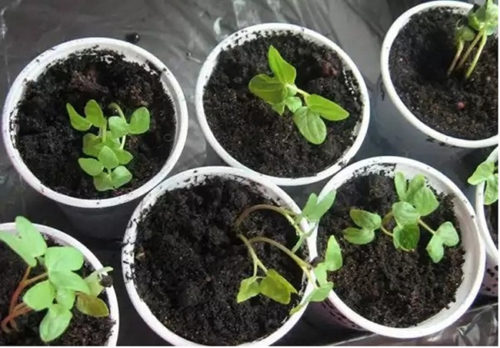
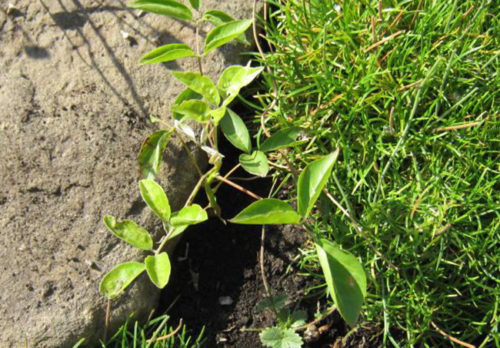
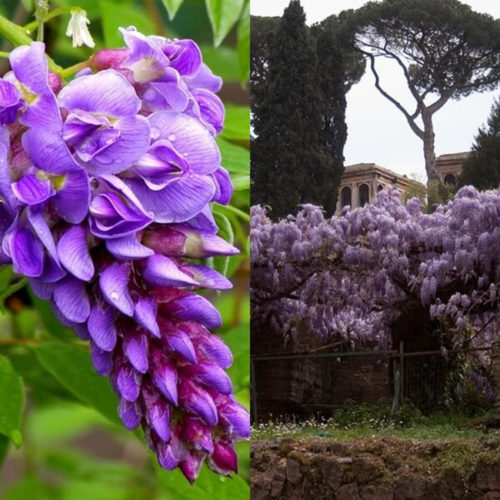
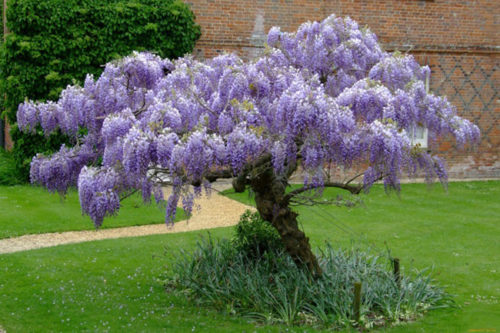
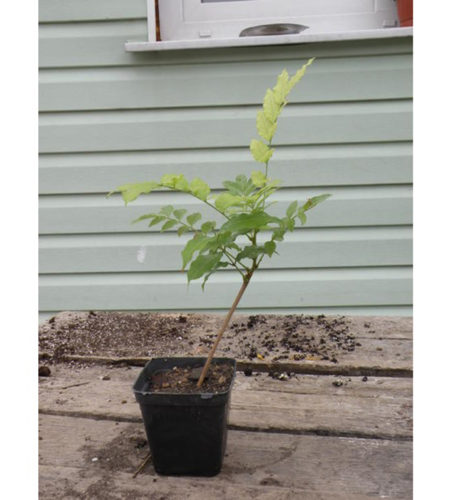
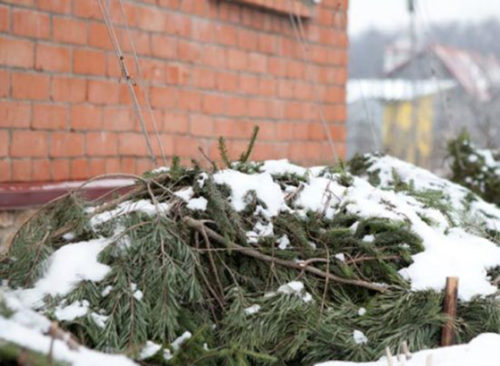
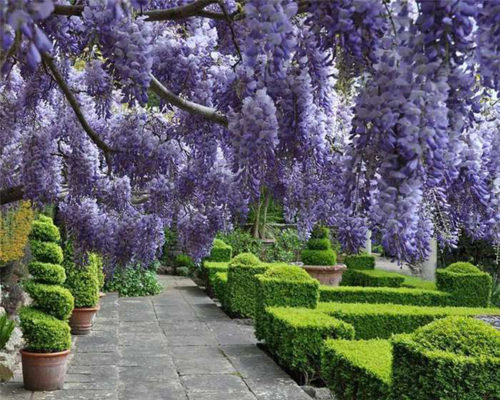
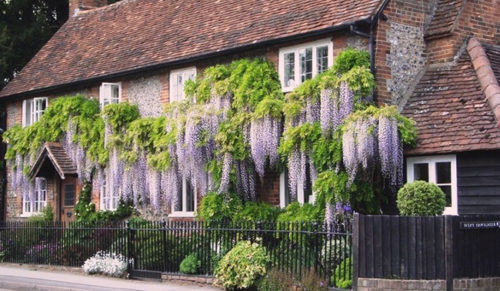
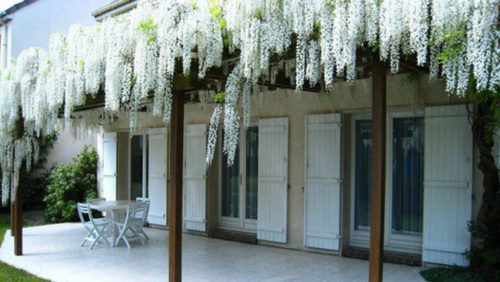
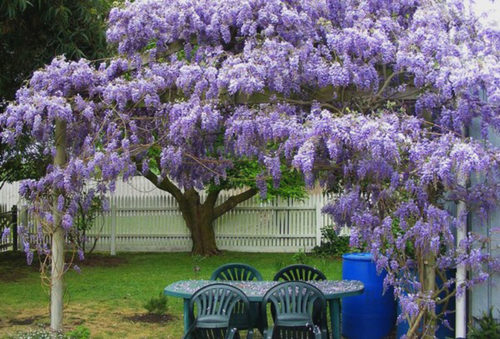
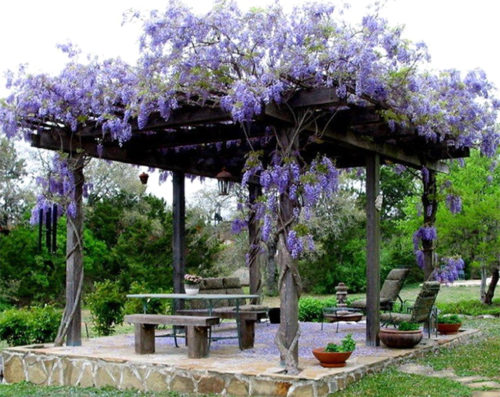












 Start a discussion ...
Start a discussion ...